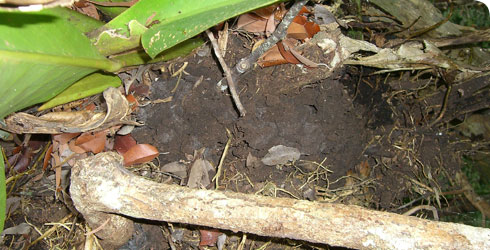Distribution and ecology
The genus Hospitalitermes is distributed from Sri Lanka and India, throughout South-east Asia and southern China, and across the Indonesia archipelago to New Guinea. They are restricted to the more stable and humid climatic conditions in tropical rainforests. They do not survive in the hotter, drier conditions that occur if the rainforest is logged.
Hospitalitermes is notable for 2 reasons:
- it is one of only a handful of genera in which the species forage in processional columns in the open-air
- while most termites feed on dead plant material, Hospitalitermes, along with Grallatotermes and Constrictotermes are the only genera known to feed on living micro-epiphytes
In the case of Hospitalitermes, they are thought to feed almost exclusively on free-living non-vascular plant tissue including:
- crustose lichens and their spores
- bryophytes
- blue-green algae
- fungal hyphae
- some woody fibres
Soldiers and workers of Hospitalitermes hospitalis leave their nest in late afternoon. They march in column formation across the forest floor to a canopy tree where they graze throughout the night on lichens and other micro-epiphytes growing high up on the trunk. If undisturbed by rain, the foraging continues until late morning.
A study of 4 colonies of Hospitalitermes hospitalis in Borneo found that colonies foraged from 5 to 7 nights out 10 nights. Usually, only 1 tree was visited per night but each colony utilised between 14 and 26 trees over a 3-month period. The average trail length from nest to foraging tree was 29 metres while the longest was 65 metres. They often made consecutive foraging visits to the largest trees, particularly Shorea species.
Up to half a million individuals from a colony can be involved in a single foraging expedition. The column is usually 2 or 3cm wide, with the workers marching up to 8 abreast. The soldiers line the flanks of the column, with their 'squirt gun' pointing outwards to defend against ants. At the foraging site, the smaller workers gnaw the micro-epiphytes from the tree trunk, and then pass the food to the larger workers who move among them collecting the food in their mandibles. For much of the night the column consists of two-way traffic: outgoing workers from the nest, and workers returning to the nest with balls of food.
